Strategic Project Management: Feasibility Report on Duplex Development
VerifiedAdded on 2022/10/02
|12
|2810
|295
Report
AI Summary
This report presents a feasibility study for a residential duplex construction project in Geelong, Victoria, Australia. It assesses the project's viability within a budget of $800,000 and a timeframe of nine months, considering factors like planning permission, legal approvals, customer requirements, economic factors, and environmental impact. The report outlines project constraints, including cost, schedule, legal and technical constraints, and location. It also defines project goals, such as constructing the duplex within budget and timeframe, and meeting customer needs. Furthermore, it analyzes macro-environment business factors like economic, competitive, resourcing, and demographic aspects, alongside micro-environment business factors such as technical expertise, time pressures, and people-related considerations. The report concludes with an overview of the project's overall feasibility and the factors that contribute to its success.
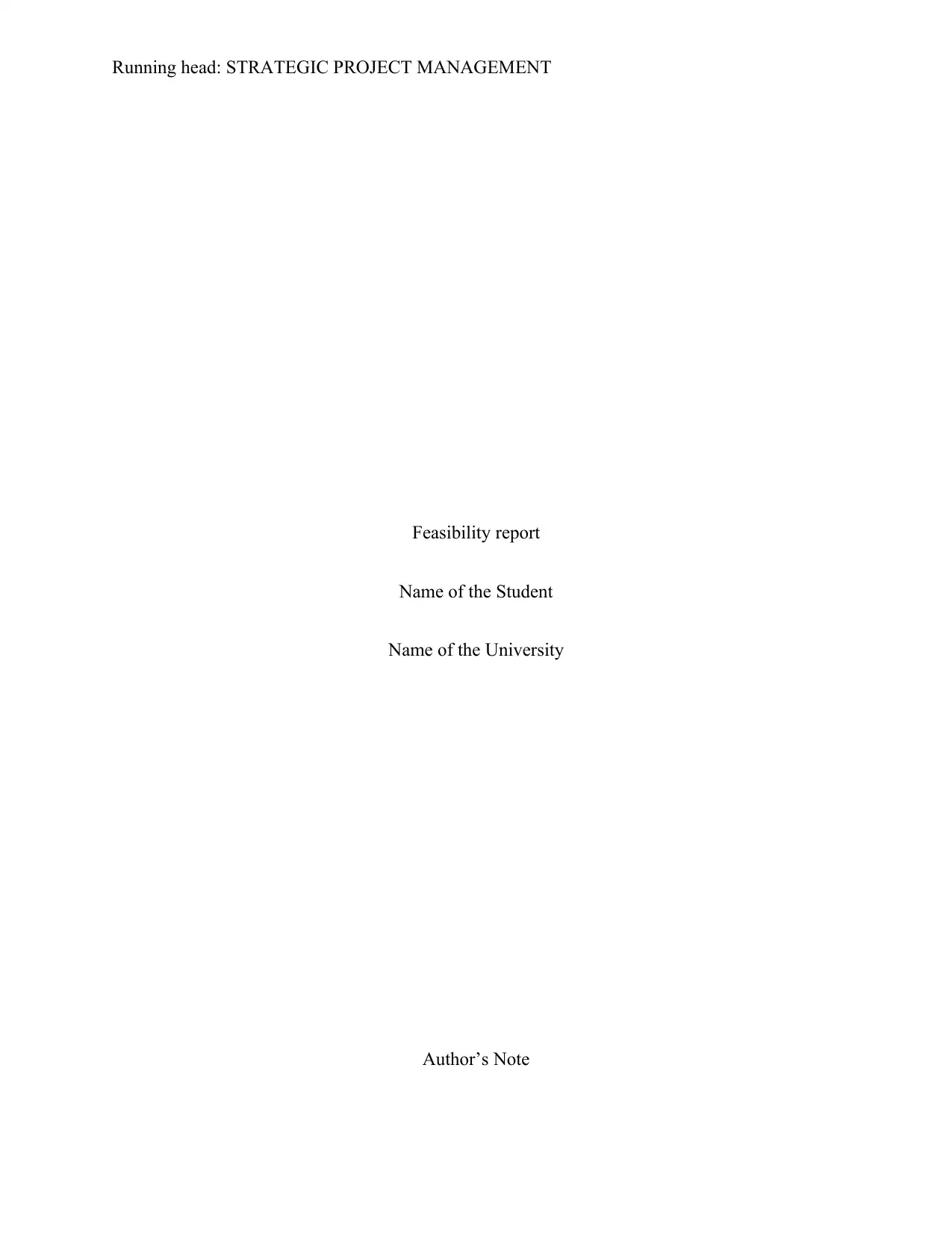
Running head: STRATEGIC PROJECT MANAGEMENT
Feasibility report
Name of the Student
Name of the University
Author’s Note
Feasibility report
Name of the Student
Name of the University
Author’s Note
Paraphrase This Document
Need a fresh take? Get an instant paraphrase of this document with our AI Paraphraser
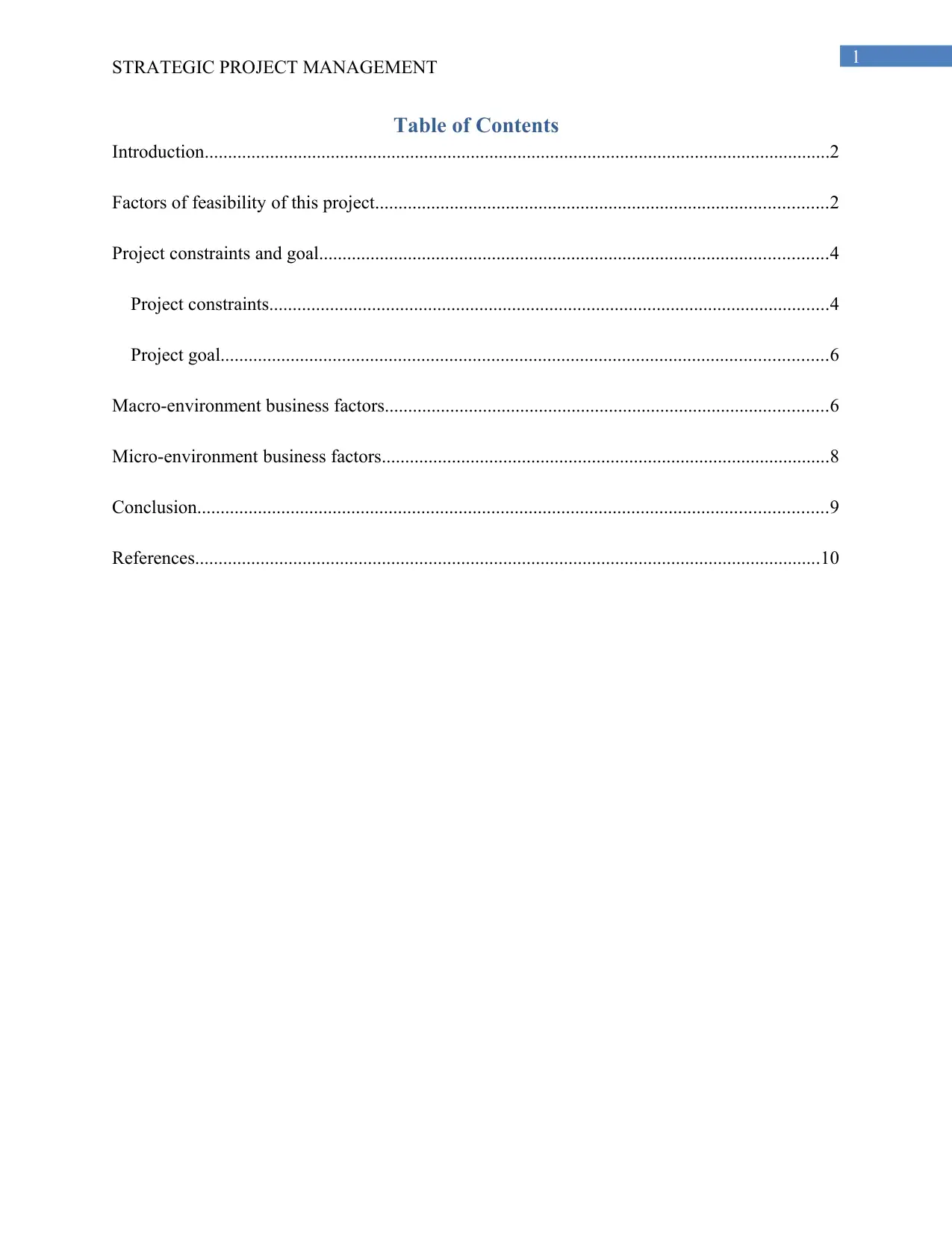
1
STRATEGIC PROJECT MANAGEMENT
Table of Contents
Introduction......................................................................................................................................2
Factors of feasibility of this project.................................................................................................2
Project constraints and goal.............................................................................................................4
Project constraints........................................................................................................................4
Project goal..................................................................................................................................6
Macro-environment business factors...............................................................................................6
Micro-environment business factors................................................................................................8
Conclusion.......................................................................................................................................9
References......................................................................................................................................10
STRATEGIC PROJECT MANAGEMENT
Table of Contents
Introduction......................................................................................................................................2
Factors of feasibility of this project.................................................................................................2
Project constraints and goal.............................................................................................................4
Project constraints........................................................................................................................4
Project goal..................................................................................................................................6
Macro-environment business factors...............................................................................................6
Micro-environment business factors................................................................................................8
Conclusion.......................................................................................................................................9
References......................................................................................................................................10
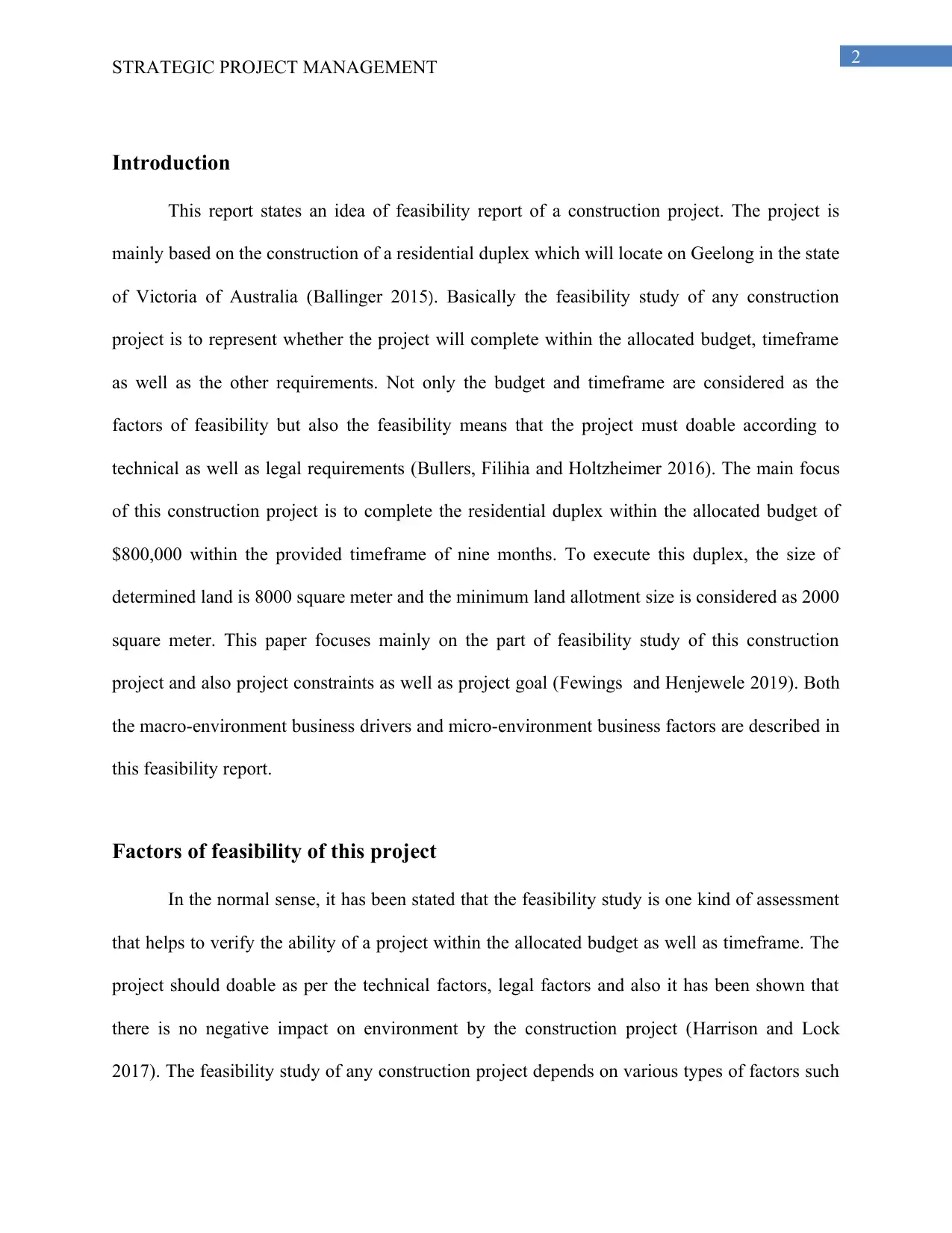
2
STRATEGIC PROJECT MANAGEMENT
Introduction
This report states an idea of feasibility report of a construction project. The project is
mainly based on the construction of a residential duplex which will locate on Geelong in the state
of Victoria of Australia (Ballinger 2015). Basically the feasibility study of any construction
project is to represent whether the project will complete within the allocated budget, timeframe
as well as the other requirements. Not only the budget and timeframe are considered as the
factors of feasibility but also the feasibility means that the project must doable according to
technical as well as legal requirements (Bullers, Filihia and Holtzheimer 2016). The main focus
of this construction project is to complete the residential duplex within the allocated budget of
$800,000 within the provided timeframe of nine months. To execute this duplex, the size of
determined land is 8000 square meter and the minimum land allotment size is considered as 2000
square meter. This paper focuses mainly on the part of feasibility study of this construction
project and also project constraints as well as project goal (Fewings and Henjewele 2019). Both
the macro-environment business drivers and micro-environment business factors are described in
this feasibility report.
Factors of feasibility of this project
In the normal sense, it has been stated that the feasibility study is one kind of assessment
that helps to verify the ability of a project within the allocated budget as well as timeframe. The
project should doable as per the technical factors, legal factors and also it has been shown that
there is no negative impact on environment by the construction project (Harrison and Lock
2017). The feasibility study of any construction project depends on various types of factors such
STRATEGIC PROJECT MANAGEMENT
Introduction
This report states an idea of feasibility report of a construction project. The project is
mainly based on the construction of a residential duplex which will locate on Geelong in the state
of Victoria of Australia (Ballinger 2015). Basically the feasibility study of any construction
project is to represent whether the project will complete within the allocated budget, timeframe
as well as the other requirements. Not only the budget and timeframe are considered as the
factors of feasibility but also the feasibility means that the project must doable according to
technical as well as legal requirements (Bullers, Filihia and Holtzheimer 2016). The main focus
of this construction project is to complete the residential duplex within the allocated budget of
$800,000 within the provided timeframe of nine months. To execute this duplex, the size of
determined land is 8000 square meter and the minimum land allotment size is considered as 2000
square meter. This paper focuses mainly on the part of feasibility study of this construction
project and also project constraints as well as project goal (Fewings and Henjewele 2019). Both
the macro-environment business drivers and micro-environment business factors are described in
this feasibility report.
Factors of feasibility of this project
In the normal sense, it has been stated that the feasibility study is one kind of assessment
that helps to verify the ability of a project within the allocated budget as well as timeframe. The
project should doable as per the technical factors, legal factors and also it has been shown that
there is no negative impact on environment by the construction project (Harrison and Lock
2017). The feasibility study of any construction project depends on various types of factors such
⊘ This is a preview!⊘
Do you want full access?
Subscribe today to unlock all pages.

Trusted by 1+ million students worldwide
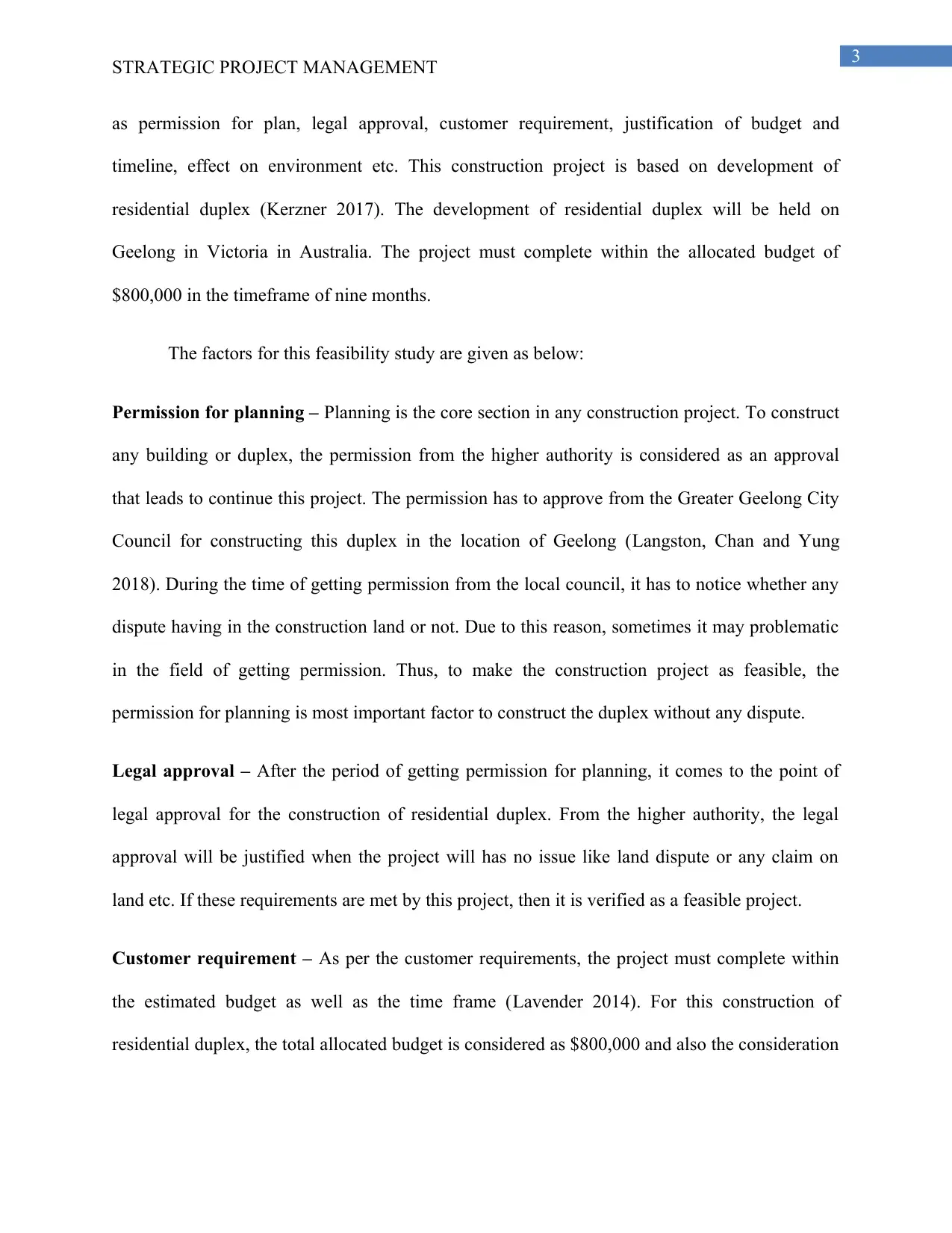
3
STRATEGIC PROJECT MANAGEMENT
as permission for plan, legal approval, customer requirement, justification of budget and
timeline, effect on environment etc. This construction project is based on development of
residential duplex (Kerzner 2017). The development of residential duplex will be held on
Geelong in Victoria in Australia. The project must complete within the allocated budget of
$800,000 in the timeframe of nine months.
The factors for this feasibility study are given as below:
Permission for planning – Planning is the core section in any construction project. To construct
any building or duplex, the permission from the higher authority is considered as an approval
that leads to continue this project. The permission has to approve from the Greater Geelong City
Council for constructing this duplex in the location of Geelong (Langston, Chan and Yung
2018). During the time of getting permission from the local council, it has to notice whether any
dispute having in the construction land or not. Due to this reason, sometimes it may problematic
in the field of getting permission. Thus, to make the construction project as feasible, the
permission for planning is most important factor to construct the duplex without any dispute.
Legal approval – After the period of getting permission for planning, it comes to the point of
legal approval for the construction of residential duplex. From the higher authority, the legal
approval will be justified when the project will has no issue like land dispute or any claim on
land etc. If these requirements are met by this project, then it is verified as a feasible project.
Customer requirement – As per the customer requirements, the project must complete within
the estimated budget as well as the time frame (Lavender 2014). For this construction of
residential duplex, the total allocated budget is considered as $800,000 and also the consideration
STRATEGIC PROJECT MANAGEMENT
as permission for plan, legal approval, customer requirement, justification of budget and
timeline, effect on environment etc. This construction project is based on development of
residential duplex (Kerzner 2017). The development of residential duplex will be held on
Geelong in Victoria in Australia. The project must complete within the allocated budget of
$800,000 in the timeframe of nine months.
The factors for this feasibility study are given as below:
Permission for planning – Planning is the core section in any construction project. To construct
any building or duplex, the permission from the higher authority is considered as an approval
that leads to continue this project. The permission has to approve from the Greater Geelong City
Council for constructing this duplex in the location of Geelong (Langston, Chan and Yung
2018). During the time of getting permission from the local council, it has to notice whether any
dispute having in the construction land or not. Due to this reason, sometimes it may problematic
in the field of getting permission. Thus, to make the construction project as feasible, the
permission for planning is most important factor to construct the duplex without any dispute.
Legal approval – After the period of getting permission for planning, it comes to the point of
legal approval for the construction of residential duplex. From the higher authority, the legal
approval will be justified when the project will has no issue like land dispute or any claim on
land etc. If these requirements are met by this project, then it is verified as a feasible project.
Customer requirement – As per the customer requirements, the project must complete within
the estimated budget as well as the time frame (Lavender 2014). For this construction of
residential duplex, the total allocated budget is considered as $800,000 and also the consideration
Paraphrase This Document
Need a fresh take? Get an instant paraphrase of this document with our AI Paraphraser
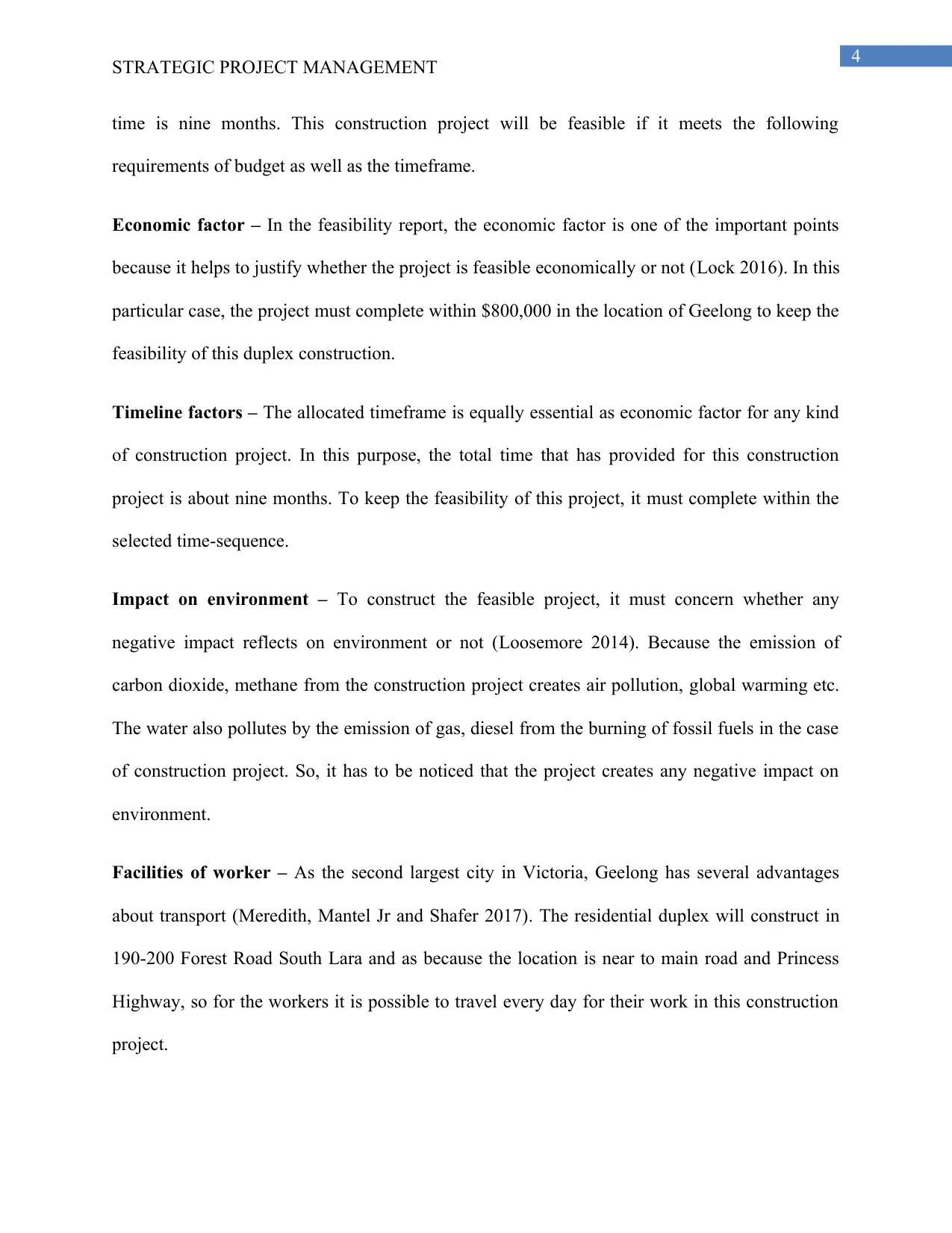
4
STRATEGIC PROJECT MANAGEMENT
time is nine months. This construction project will be feasible if it meets the following
requirements of budget as well as the timeframe.
Economic factor – In the feasibility report, the economic factor is one of the important points
because it helps to justify whether the project is feasible economically or not (Lock 2016). In this
particular case, the project must complete within $800,000 in the location of Geelong to keep the
feasibility of this duplex construction.
Timeline factors – The allocated timeframe is equally essential as economic factor for any kind
of construction project. In this purpose, the total time that has provided for this construction
project is about nine months. To keep the feasibility of this project, it must complete within the
selected time-sequence.
Impact on environment – To construct the feasible project, it must concern whether any
negative impact reflects on environment or not (Loosemore 2014). Because the emission of
carbon dioxide, methane from the construction project creates air pollution, global warming etc.
The water also pollutes by the emission of gas, diesel from the burning of fossil fuels in the case
of construction project. So, it has to be noticed that the project creates any negative impact on
environment.
Facilities of worker – As the second largest city in Victoria, Geelong has several advantages
about transport (Meredith, Mantel Jr and Shafer 2017). The residential duplex will construct in
190-200 Forest Road South Lara and as because the location is near to main road and Princess
Highway, so for the workers it is possible to travel every day for their work in this construction
project.
STRATEGIC PROJECT MANAGEMENT
time is nine months. This construction project will be feasible if it meets the following
requirements of budget as well as the timeframe.
Economic factor – In the feasibility report, the economic factor is one of the important points
because it helps to justify whether the project is feasible economically or not (Lock 2016). In this
particular case, the project must complete within $800,000 in the location of Geelong to keep the
feasibility of this duplex construction.
Timeline factors – The allocated timeframe is equally essential as economic factor for any kind
of construction project. In this purpose, the total time that has provided for this construction
project is about nine months. To keep the feasibility of this project, it must complete within the
selected time-sequence.
Impact on environment – To construct the feasible project, it must concern whether any
negative impact reflects on environment or not (Loosemore 2014). Because the emission of
carbon dioxide, methane from the construction project creates air pollution, global warming etc.
The water also pollutes by the emission of gas, diesel from the burning of fossil fuels in the case
of construction project. So, it has to be noticed that the project creates any negative impact on
environment.
Facilities of worker – As the second largest city in Victoria, Geelong has several advantages
about transport (Meredith, Mantel Jr and Shafer 2017). The residential duplex will construct in
190-200 Forest Road South Lara and as because the location is near to main road and Princess
Highway, so for the workers it is possible to travel every day for their work in this construction
project.
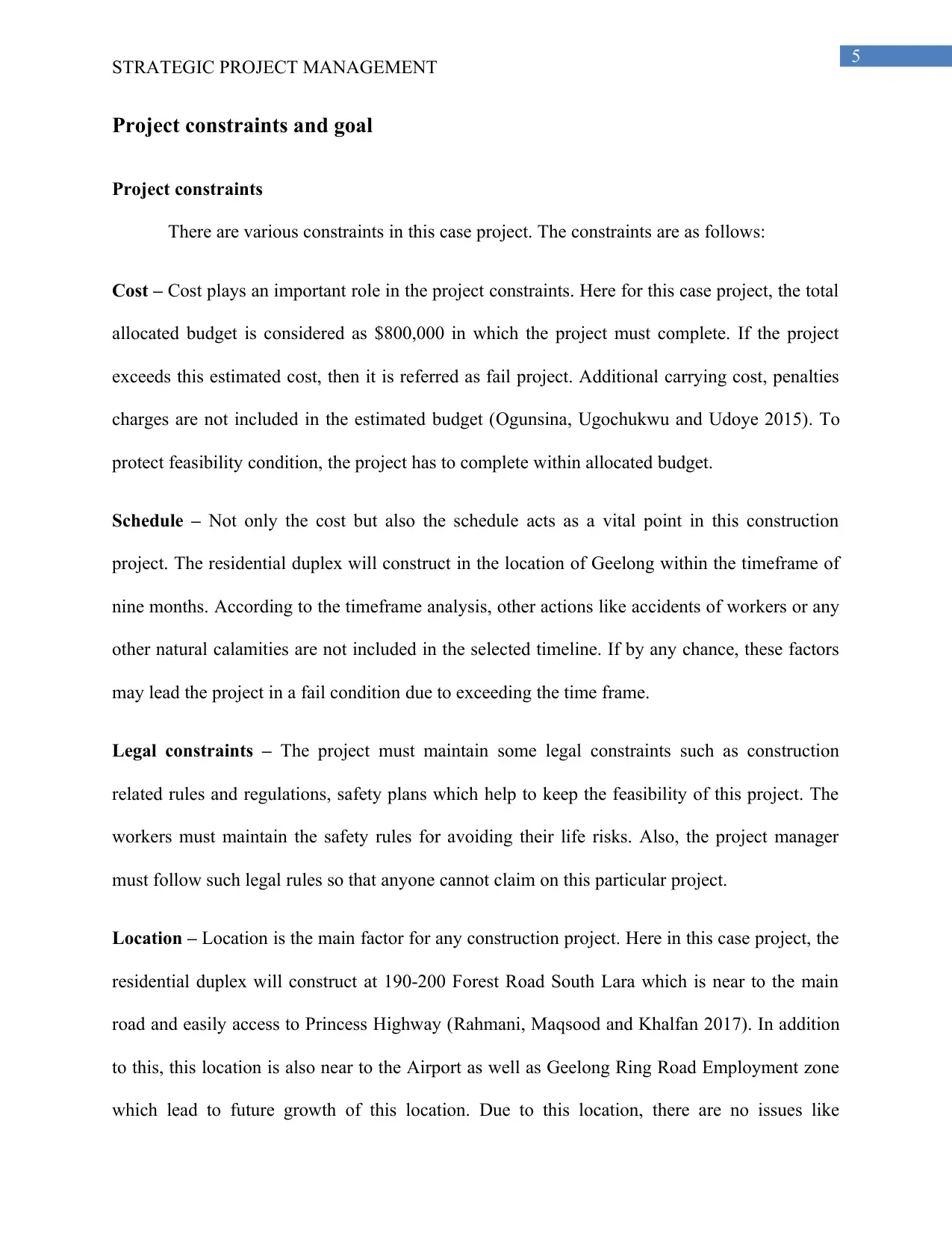
5
STRATEGIC PROJECT MANAGEMENT
Project constraints and goal
Project constraints
There are various constraints in this case project. The constraints are as follows:
Cost – Cost plays an important role in the project constraints. Here for this case project, the total
allocated budget is considered as $800,000 in which the project must complete. If the project
exceeds this estimated cost, then it is referred as fail project. Additional carrying cost, penalties
charges are not included in the estimated budget (Ogunsina, Ugochukwu and Udoye 2015). To
protect feasibility condition, the project has to complete within allocated budget.
Schedule – Not only the cost but also the schedule acts as a vital point in this construction
project. The residential duplex will construct in the location of Geelong within the timeframe of
nine months. According to the timeframe analysis, other actions like accidents of workers or any
other natural calamities are not included in the selected timeline. If by any chance, these factors
may lead the project in a fail condition due to exceeding the time frame.
Legal constraints – The project must maintain some legal constraints such as construction
related rules and regulations, safety plans which help to keep the feasibility of this project. The
workers must maintain the safety rules for avoiding their life risks. Also, the project manager
must follow such legal rules so that anyone cannot claim on this particular project.
Location – Location is the main factor for any construction project. Here in this case project, the
residential duplex will construct at 190-200 Forest Road South Lara which is near to the main
road and easily access to Princess Highway (Rahmani, Maqsood and Khalfan 2017). In addition
to this, this location is also near to the Airport as well as Geelong Ring Road Employment zone
which lead to future growth of this location. Due to this location, there are no issues like
STRATEGIC PROJECT MANAGEMENT
Project constraints and goal
Project constraints
There are various constraints in this case project. The constraints are as follows:
Cost – Cost plays an important role in the project constraints. Here for this case project, the total
allocated budget is considered as $800,000 in which the project must complete. If the project
exceeds this estimated cost, then it is referred as fail project. Additional carrying cost, penalties
charges are not included in the estimated budget (Ogunsina, Ugochukwu and Udoye 2015). To
protect feasibility condition, the project has to complete within allocated budget.
Schedule – Not only the cost but also the schedule acts as a vital point in this construction
project. The residential duplex will construct in the location of Geelong within the timeframe of
nine months. According to the timeframe analysis, other actions like accidents of workers or any
other natural calamities are not included in the selected timeline. If by any chance, these factors
may lead the project in a fail condition due to exceeding the time frame.
Legal constraints – The project must maintain some legal constraints such as construction
related rules and regulations, safety plans which help to keep the feasibility of this project. The
workers must maintain the safety rules for avoiding their life risks. Also, the project manager
must follow such legal rules so that anyone cannot claim on this particular project.
Location – Location is the main factor for any construction project. Here in this case project, the
residential duplex will construct at 190-200 Forest Road South Lara which is near to the main
road and easily access to Princess Highway (Rahmani, Maqsood and Khalfan 2017). In addition
to this, this location is also near to the Airport as well as Geelong Ring Road Employment zone
which lead to future growth of this location. Due to this location, there are no issues like
⊘ This is a preview!⊘
Do you want full access?
Subscribe today to unlock all pages.

Trusted by 1+ million students worldwide
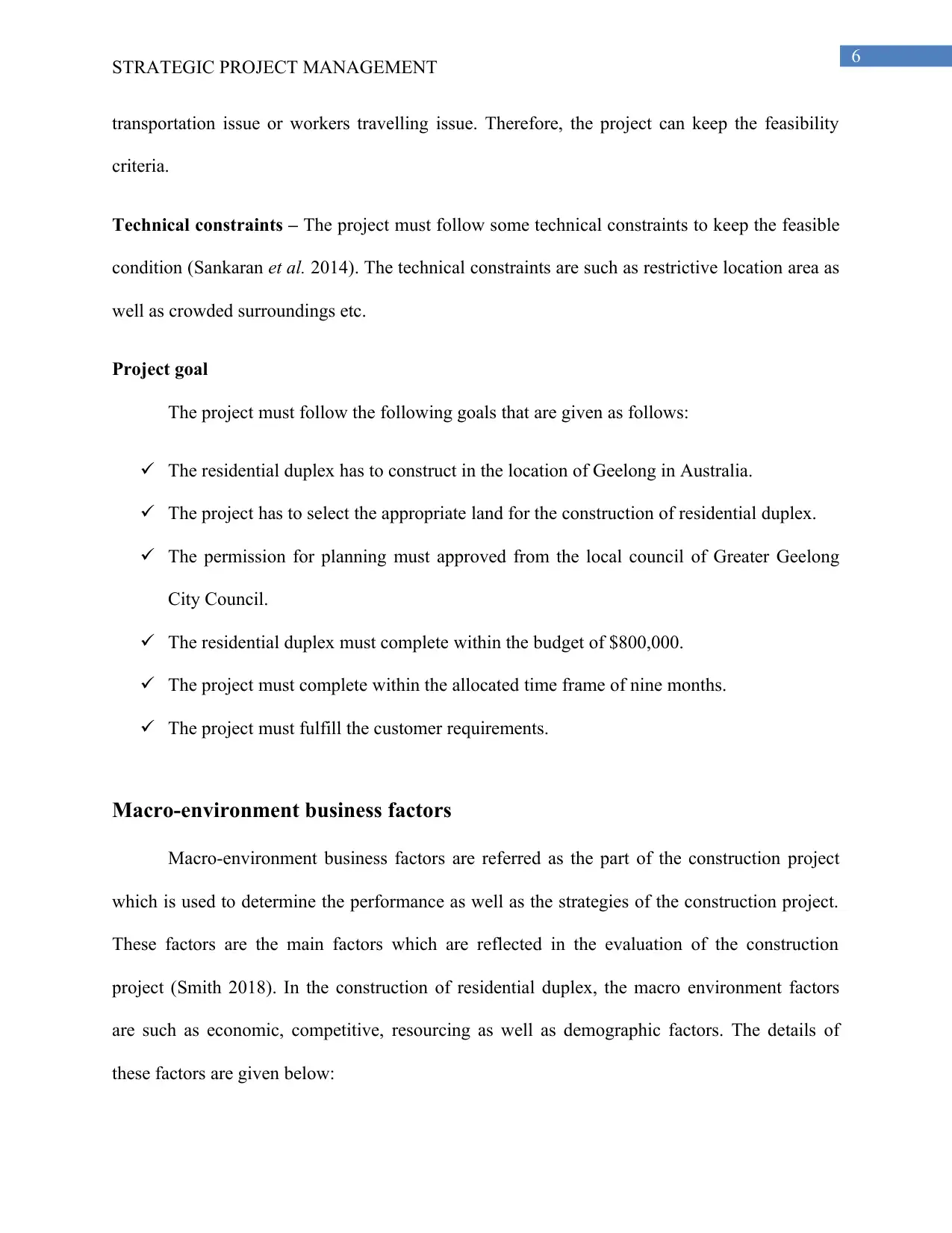
6
STRATEGIC PROJECT MANAGEMENT
transportation issue or workers travelling issue. Therefore, the project can keep the feasibility
criteria.
Technical constraints – The project must follow some technical constraints to keep the feasible
condition (Sankaran et al. 2014). The technical constraints are such as restrictive location area as
well as crowded surroundings etc.
Project goal
The project must follow the following goals that are given as follows:
The residential duplex has to construct in the location of Geelong in Australia.
The project has to select the appropriate land for the construction of residential duplex.
The permission for planning must approved from the local council of Greater Geelong
City Council.
The residential duplex must complete within the budget of $800,000.
The project must complete within the allocated time frame of nine months.
The project must fulfill the customer requirements.
Macro-environment business factors
Macro-environment business factors are referred as the part of the construction project
which is used to determine the performance as well as the strategies of the construction project.
These factors are the main factors which are reflected in the evaluation of the construction
project (Smith 2018). In the construction of residential duplex, the macro environment factors
are such as economic, competitive, resourcing as well as demographic factors. The details of
these factors are given below:
STRATEGIC PROJECT MANAGEMENT
transportation issue or workers travelling issue. Therefore, the project can keep the feasibility
criteria.
Technical constraints – The project must follow some technical constraints to keep the feasible
condition (Sankaran et al. 2014). The technical constraints are such as restrictive location area as
well as crowded surroundings etc.
Project goal
The project must follow the following goals that are given as follows:
The residential duplex has to construct in the location of Geelong in Australia.
The project has to select the appropriate land for the construction of residential duplex.
The permission for planning must approved from the local council of Greater Geelong
City Council.
The residential duplex must complete within the budget of $800,000.
The project must complete within the allocated time frame of nine months.
The project must fulfill the customer requirements.
Macro-environment business factors
Macro-environment business factors are referred as the part of the construction project
which is used to determine the performance as well as the strategies of the construction project.
These factors are the main factors which are reflected in the evaluation of the construction
project (Smith 2018). In the construction of residential duplex, the macro environment factors
are such as economic, competitive, resourcing as well as demographic factors. The details of
these factors are given below:
Paraphrase This Document
Need a fresh take? Get an instant paraphrase of this document with our AI Paraphraser
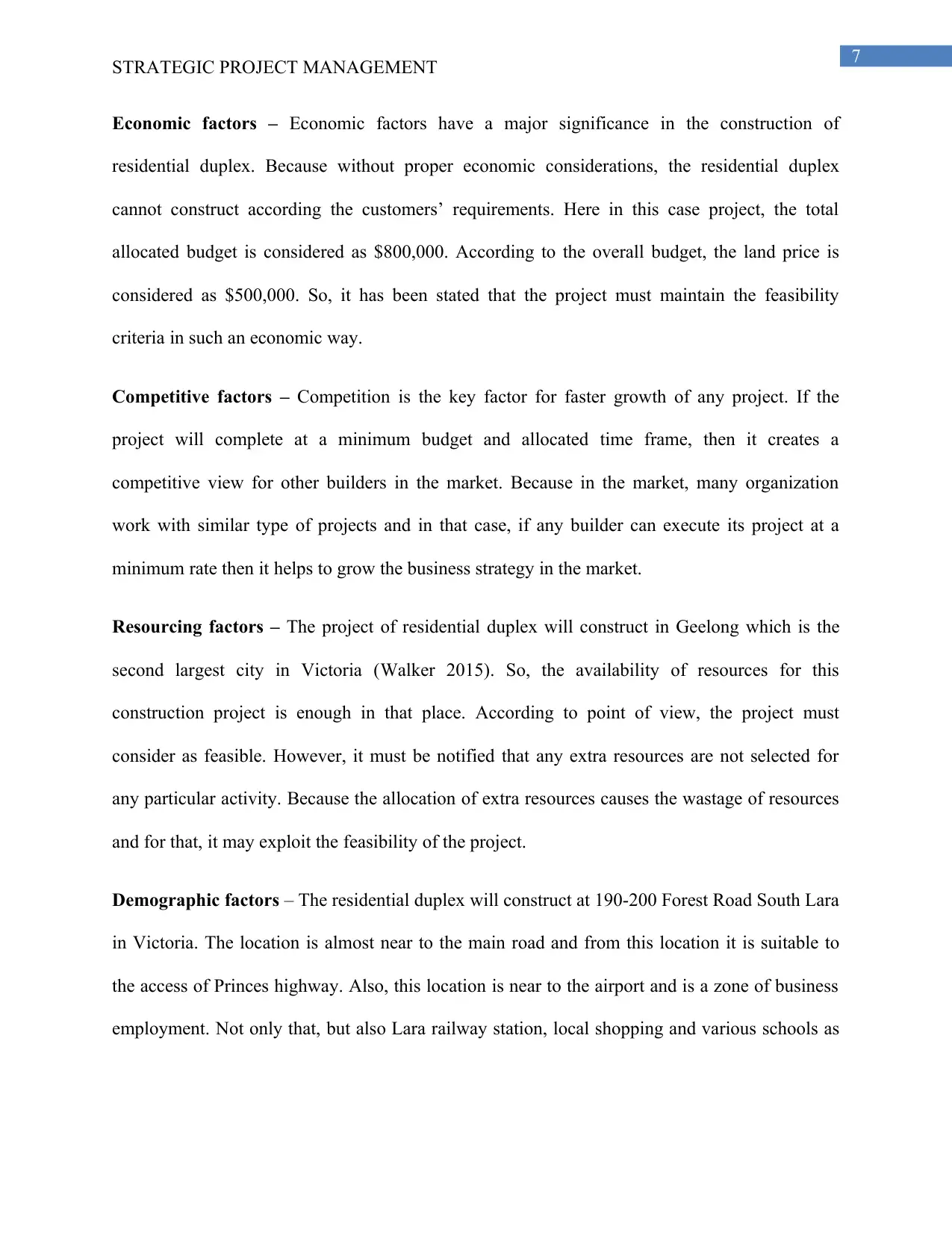
7
STRATEGIC PROJECT MANAGEMENT
Economic factors – Economic factors have a major significance in the construction of
residential duplex. Because without proper economic considerations, the residential duplex
cannot construct according the customers’ requirements. Here in this case project, the total
allocated budget is considered as $800,000. According to the overall budget, the land price is
considered as $500,000. So, it has been stated that the project must maintain the feasibility
criteria in such an economic way.
Competitive factors – Competition is the key factor for faster growth of any project. If the
project will complete at a minimum budget and allocated time frame, then it creates a
competitive view for other builders in the market. Because in the market, many organization
work with similar type of projects and in that case, if any builder can execute its project at a
minimum rate then it helps to grow the business strategy in the market.
Resourcing factors – The project of residential duplex will construct in Geelong which is the
second largest city in Victoria (Walker 2015). So, the availability of resources for this
construction project is enough in that place. According to point of view, the project must
consider as feasible. However, it must be notified that any extra resources are not selected for
any particular activity. Because the allocation of extra resources causes the wastage of resources
and for that, it may exploit the feasibility of the project.
Demographic factors – The residential duplex will construct at 190-200 Forest Road South Lara
in Victoria. The location is almost near to the main road and from this location it is suitable to
the access of Princes highway. Also, this location is near to the airport and is a zone of business
employment. Not only that, but also Lara railway station, local shopping and various schools as
STRATEGIC PROJECT MANAGEMENT
Economic factors – Economic factors have a major significance in the construction of
residential duplex. Because without proper economic considerations, the residential duplex
cannot construct according the customers’ requirements. Here in this case project, the total
allocated budget is considered as $800,000. According to the overall budget, the land price is
considered as $500,000. So, it has been stated that the project must maintain the feasibility
criteria in such an economic way.
Competitive factors – Competition is the key factor for faster growth of any project. If the
project will complete at a minimum budget and allocated time frame, then it creates a
competitive view for other builders in the market. Because in the market, many organization
work with similar type of projects and in that case, if any builder can execute its project at a
minimum rate then it helps to grow the business strategy in the market.
Resourcing factors – The project of residential duplex will construct in Geelong which is the
second largest city in Victoria (Walker 2015). So, the availability of resources for this
construction project is enough in that place. According to point of view, the project must
consider as feasible. However, it must be notified that any extra resources are not selected for
any particular activity. Because the allocation of extra resources causes the wastage of resources
and for that, it may exploit the feasibility of the project.
Demographic factors – The residential duplex will construct at 190-200 Forest Road South Lara
in Victoria. The location is almost near to the main road and from this location it is suitable to
the access of Princes highway. Also, this location is near to the airport and is a zone of business
employment. Not only that, but also Lara railway station, local shopping and various schools as
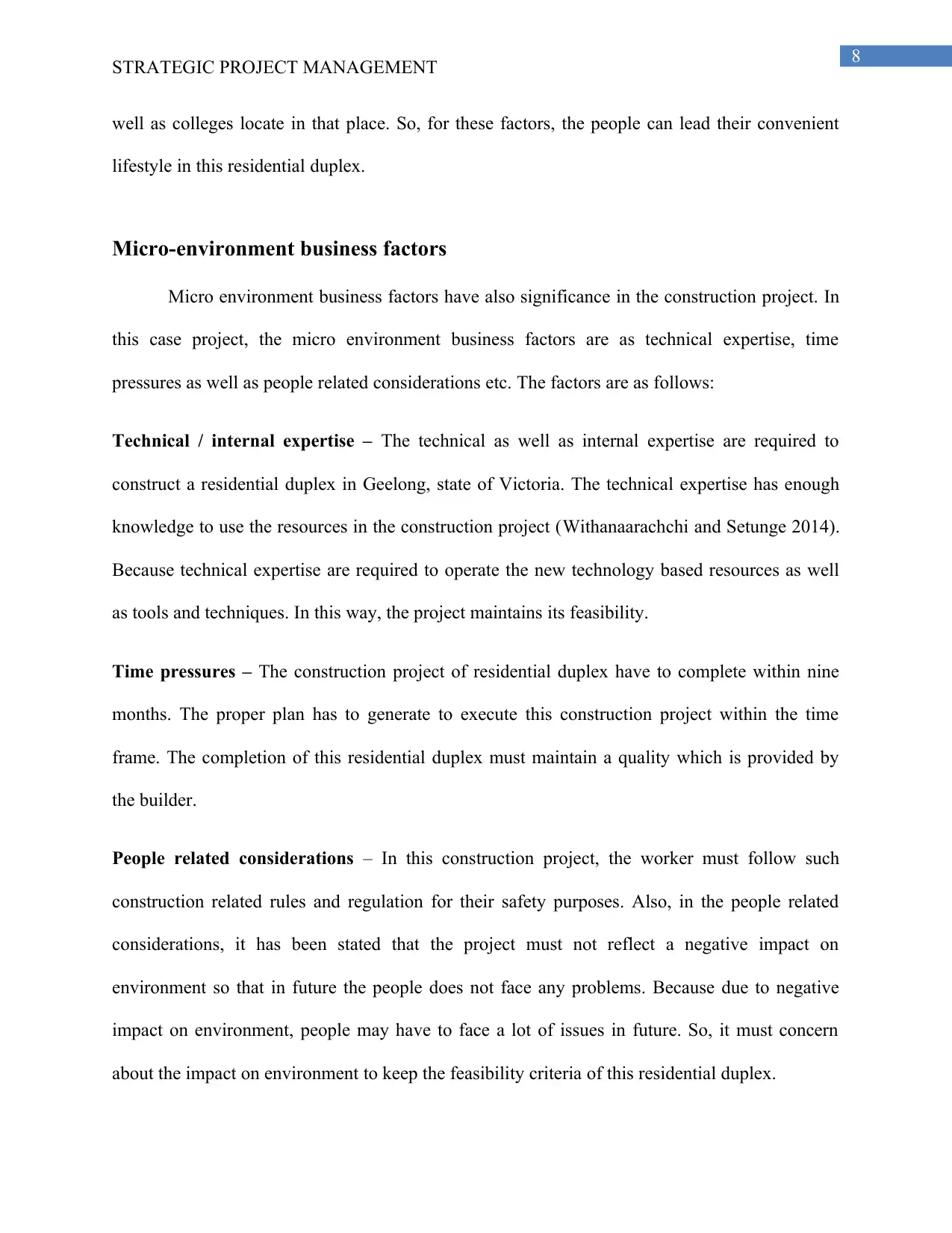
8
STRATEGIC PROJECT MANAGEMENT
well as colleges locate in that place. So, for these factors, the people can lead their convenient
lifestyle in this residential duplex.
Micro-environment business factors
Micro environment business factors have also significance in the construction project. In
this case project, the micro environment business factors are as technical expertise, time
pressures as well as people related considerations etc. The factors are as follows:
Technical / internal expertise – The technical as well as internal expertise are required to
construct a residential duplex in Geelong, state of Victoria. The technical expertise has enough
knowledge to use the resources in the construction project (Withanaarachchi and Setunge 2014).
Because technical expertise are required to operate the new technology based resources as well
as tools and techniques. In this way, the project maintains its feasibility.
Time pressures – The construction project of residential duplex have to complete within nine
months. The proper plan has to generate to execute this construction project within the time
frame. The completion of this residential duplex must maintain a quality which is provided by
the builder.
People related considerations – In this construction project, the worker must follow such
construction related rules and regulation for their safety purposes. Also, in the people related
considerations, it has been stated that the project must not reflect a negative impact on
environment so that in future the people does not face any problems. Because due to negative
impact on environment, people may have to face a lot of issues in future. So, it must concern
about the impact on environment to keep the feasibility criteria of this residential duplex.
STRATEGIC PROJECT MANAGEMENT
well as colleges locate in that place. So, for these factors, the people can lead their convenient
lifestyle in this residential duplex.
Micro-environment business factors
Micro environment business factors have also significance in the construction project. In
this case project, the micro environment business factors are as technical expertise, time
pressures as well as people related considerations etc. The factors are as follows:
Technical / internal expertise – The technical as well as internal expertise are required to
construct a residential duplex in Geelong, state of Victoria. The technical expertise has enough
knowledge to use the resources in the construction project (Withanaarachchi and Setunge 2014).
Because technical expertise are required to operate the new technology based resources as well
as tools and techniques. In this way, the project maintains its feasibility.
Time pressures – The construction project of residential duplex have to complete within nine
months. The proper plan has to generate to execute this construction project within the time
frame. The completion of this residential duplex must maintain a quality which is provided by
the builder.
People related considerations – In this construction project, the worker must follow such
construction related rules and regulation for their safety purposes. Also, in the people related
considerations, it has been stated that the project must not reflect a negative impact on
environment so that in future the people does not face any problems. Because due to negative
impact on environment, people may have to face a lot of issues in future. So, it must concern
about the impact on environment to keep the feasibility criteria of this residential duplex.
⊘ This is a preview!⊘
Do you want full access?
Subscribe today to unlock all pages.

Trusted by 1+ million students worldwide
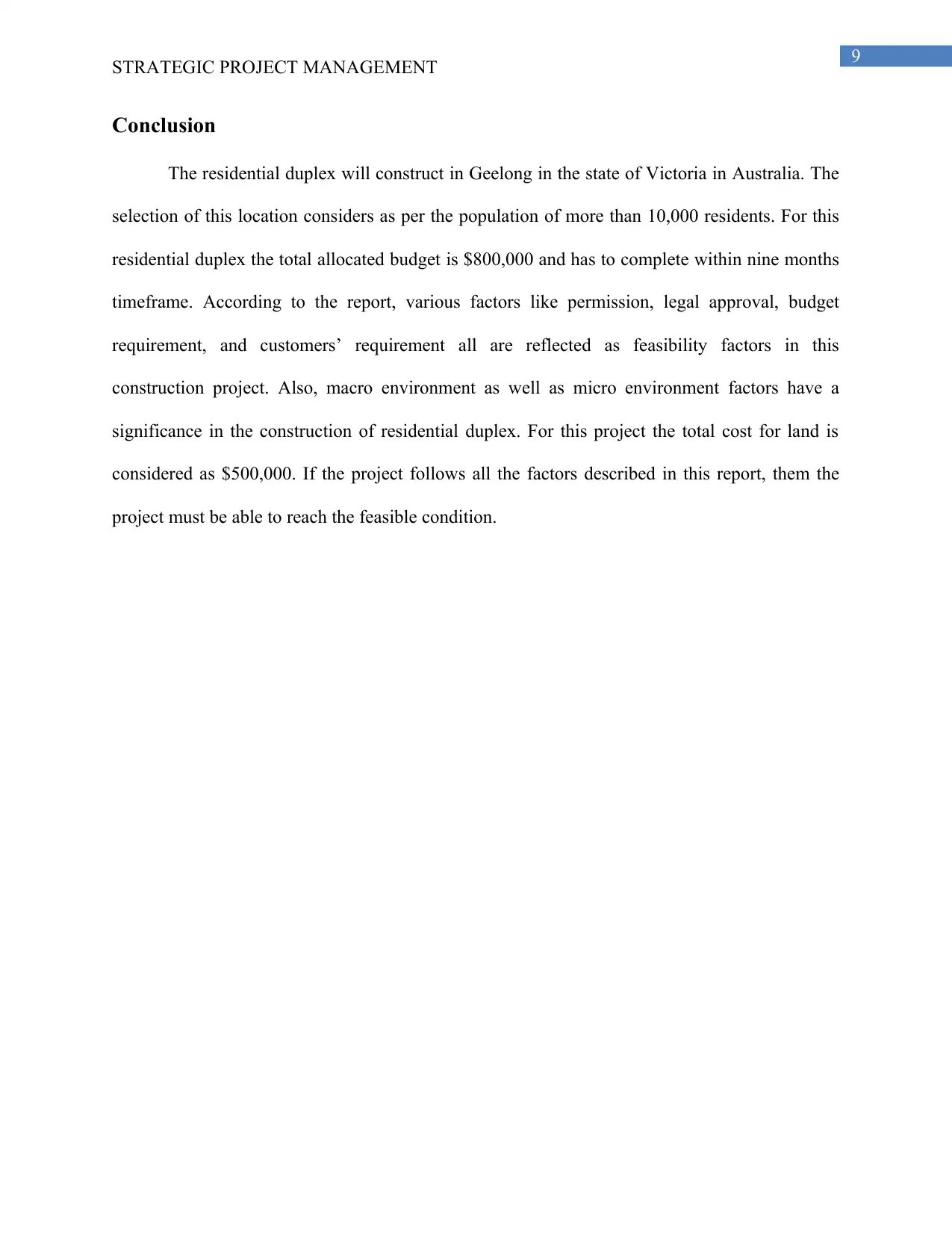
9
STRATEGIC PROJECT MANAGEMENT
Conclusion
The residential duplex will construct in Geelong in the state of Victoria in Australia. The
selection of this location considers as per the population of more than 10,000 residents. For this
residential duplex the total allocated budget is $800,000 and has to complete within nine months
timeframe. According to the report, various factors like permission, legal approval, budget
requirement, and customers’ requirement all are reflected as feasibility factors in this
construction project. Also, macro environment as well as micro environment factors have a
significance in the construction of residential duplex. For this project the total cost for land is
considered as $500,000. If the project follows all the factors described in this report, them the
project must be able to reach the feasible condition.
STRATEGIC PROJECT MANAGEMENT
Conclusion
The residential duplex will construct in Geelong in the state of Victoria in Australia. The
selection of this location considers as per the population of more than 10,000 residents. For this
residential duplex the total allocated budget is $800,000 and has to complete within nine months
timeframe. According to the report, various factors like permission, legal approval, budget
requirement, and customers’ requirement all are reflected as feasibility factors in this
construction project. Also, macro environment as well as micro environment factors have a
significance in the construction of residential duplex. For this project the total cost for land is
considered as $500,000. If the project follows all the factors described in this report, them the
project must be able to reach the feasible condition.
Paraphrase This Document
Need a fresh take? Get an instant paraphrase of this document with our AI Paraphraser
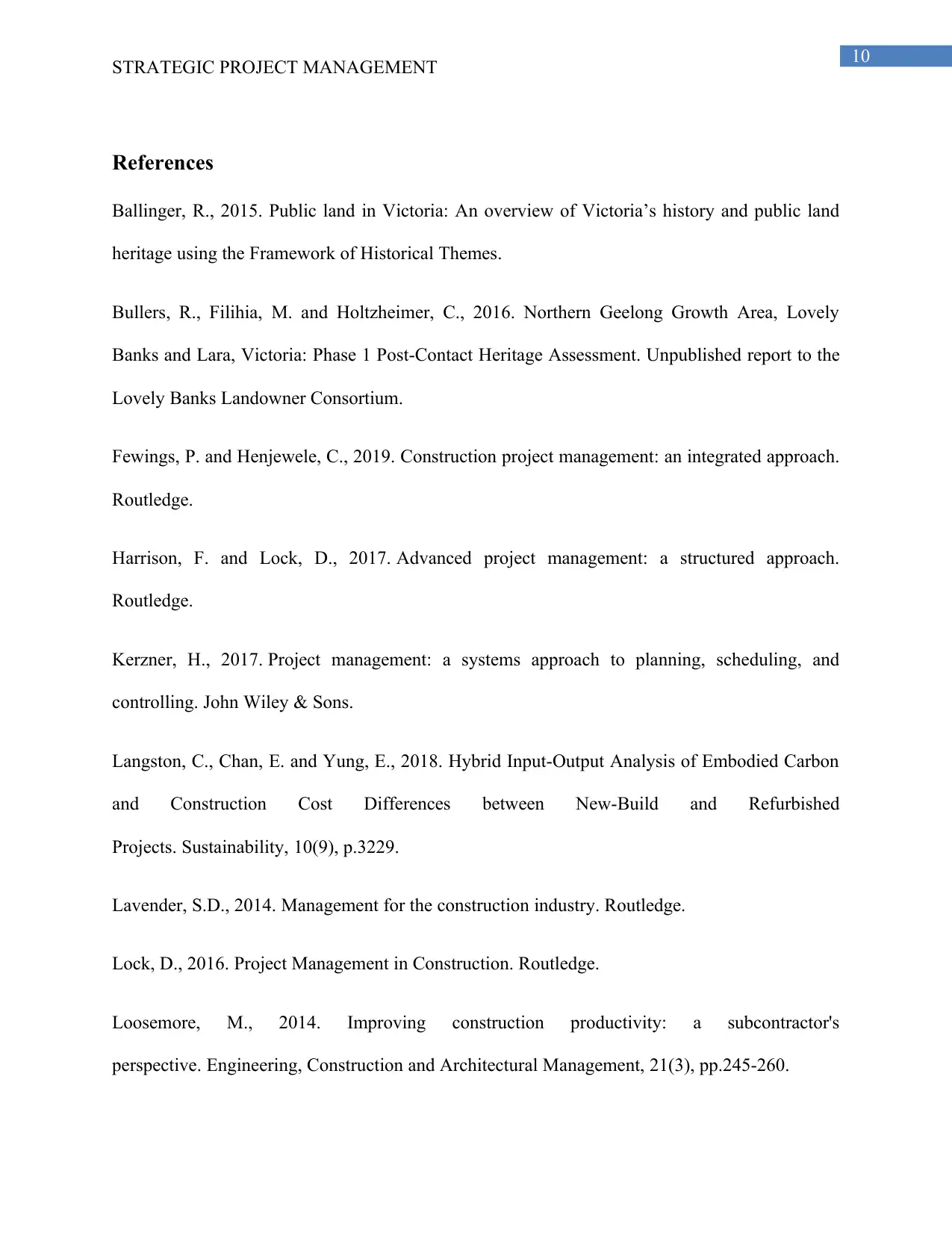
10
STRATEGIC PROJECT MANAGEMENT
References
Ballinger, R., 2015. Public land in Victoria: An overview of Victoria’s history and public land
heritage using the Framework of Historical Themes.
Bullers, R., Filihia, M. and Holtzheimer, C., 2016. Northern Geelong Growth Area, Lovely
Banks and Lara, Victoria: Phase 1 Post-Contact Heritage Assessment. Unpublished report to the
Lovely Banks Landowner Consortium.
Fewings, P. and Henjewele, C., 2019. Construction project management: an integrated approach.
Routledge.
Harrison, F. and Lock, D., 2017. Advanced project management: a structured approach.
Routledge.
Kerzner, H., 2017. Project management: a systems approach to planning, scheduling, and
controlling. John Wiley & Sons.
Langston, C., Chan, E. and Yung, E., 2018. Hybrid Input-Output Analysis of Embodied Carbon
and Construction Cost Differences between New-Build and Refurbished
Projects. Sustainability, 10(9), p.3229.
Lavender, S.D., 2014. Management for the construction industry. Routledge.
Lock, D., 2016. Project Management in Construction. Routledge.
Loosemore, M., 2014. Improving construction productivity: a subcontractor's
perspective. Engineering, Construction and Architectural Management, 21(3), pp.245-260.
STRATEGIC PROJECT MANAGEMENT
References
Ballinger, R., 2015. Public land in Victoria: An overview of Victoria’s history and public land
heritage using the Framework of Historical Themes.
Bullers, R., Filihia, M. and Holtzheimer, C., 2016. Northern Geelong Growth Area, Lovely
Banks and Lara, Victoria: Phase 1 Post-Contact Heritage Assessment. Unpublished report to the
Lovely Banks Landowner Consortium.
Fewings, P. and Henjewele, C., 2019. Construction project management: an integrated approach.
Routledge.
Harrison, F. and Lock, D., 2017. Advanced project management: a structured approach.
Routledge.
Kerzner, H., 2017. Project management: a systems approach to planning, scheduling, and
controlling. John Wiley & Sons.
Langston, C., Chan, E. and Yung, E., 2018. Hybrid Input-Output Analysis of Embodied Carbon
and Construction Cost Differences between New-Build and Refurbished
Projects. Sustainability, 10(9), p.3229.
Lavender, S.D., 2014. Management for the construction industry. Routledge.
Lock, D., 2016. Project Management in Construction. Routledge.
Loosemore, M., 2014. Improving construction productivity: a subcontractor's
perspective. Engineering, Construction and Architectural Management, 21(3), pp.245-260.
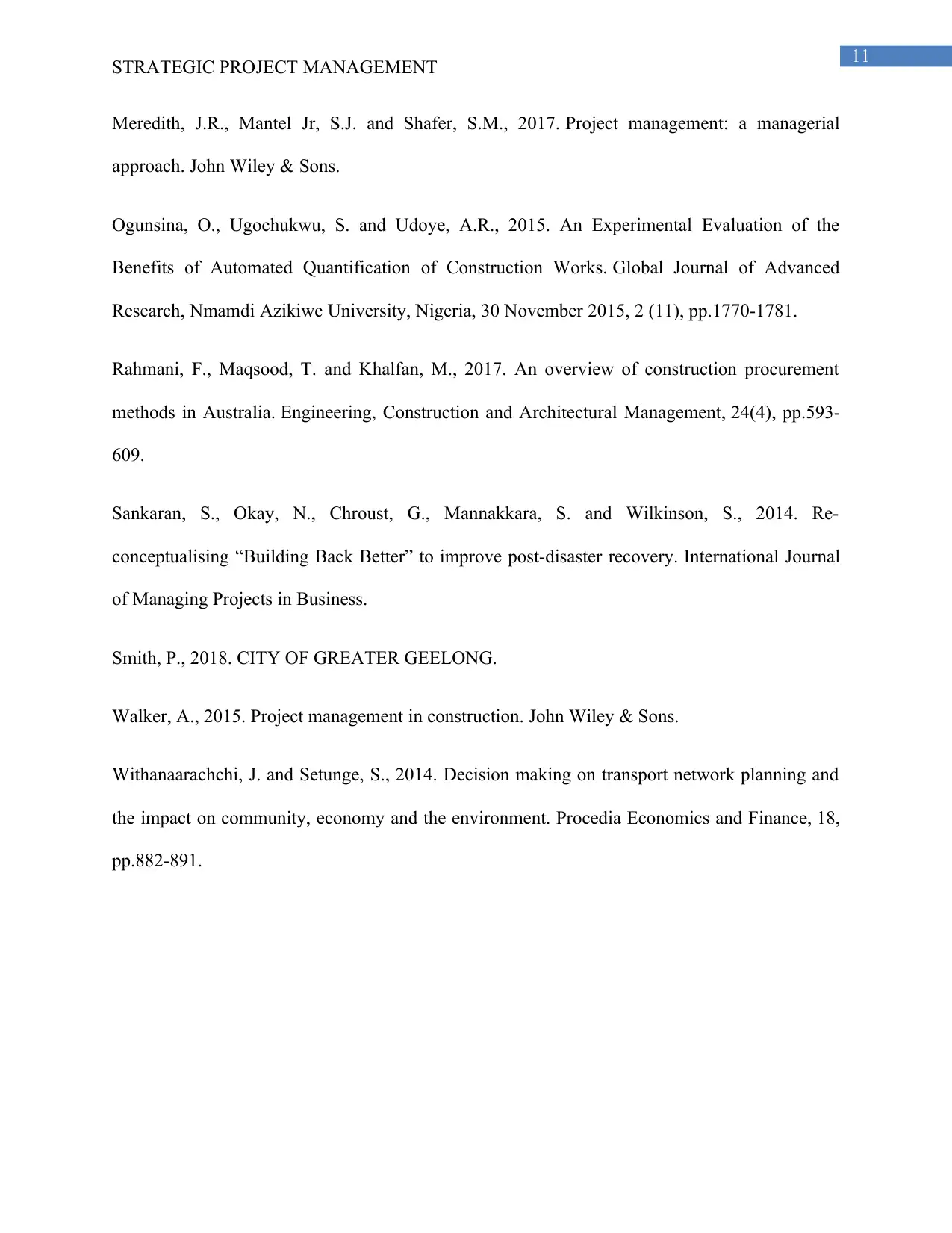
11
STRATEGIC PROJECT MANAGEMENT
Meredith, J.R., Mantel Jr, S.J. and Shafer, S.M., 2017. Project management: a managerial
approach. John Wiley & Sons.
Ogunsina, O., Ugochukwu, S. and Udoye, A.R., 2015. An Experimental Evaluation of the
Benefits of Automated Quantification of Construction Works. Global Journal of Advanced
Research, Nmamdi Azikiwe University, Nigeria, 30 November 2015, 2 (11), pp.1770-1781.
Rahmani, F., Maqsood, T. and Khalfan, M., 2017. An overview of construction procurement
methods in Australia. Engineering, Construction and Architectural Management, 24(4), pp.593-
609.
Sankaran, S., Okay, N., Chroust, G., Mannakkara, S. and Wilkinson, S., 2014. Re-
conceptualising “Building Back Better” to improve post-disaster recovery. International Journal
of Managing Projects in Business.
Smith, P., 2018. CITY OF GREATER GEELONG.
Walker, A., 2015. Project management in construction. John Wiley & Sons.
Withanaarachchi, J. and Setunge, S., 2014. Decision making on transport network planning and
the impact on community, economy and the environment. Procedia Economics and Finance, 18,
pp.882-891.
STRATEGIC PROJECT MANAGEMENT
Meredith, J.R., Mantel Jr, S.J. and Shafer, S.M., 2017. Project management: a managerial
approach. John Wiley & Sons.
Ogunsina, O., Ugochukwu, S. and Udoye, A.R., 2015. An Experimental Evaluation of the
Benefits of Automated Quantification of Construction Works. Global Journal of Advanced
Research, Nmamdi Azikiwe University, Nigeria, 30 November 2015, 2 (11), pp.1770-1781.
Rahmani, F., Maqsood, T. and Khalfan, M., 2017. An overview of construction procurement
methods in Australia. Engineering, Construction and Architectural Management, 24(4), pp.593-
609.
Sankaran, S., Okay, N., Chroust, G., Mannakkara, S. and Wilkinson, S., 2014. Re-
conceptualising “Building Back Better” to improve post-disaster recovery. International Journal
of Managing Projects in Business.
Smith, P., 2018. CITY OF GREATER GEELONG.
Walker, A., 2015. Project management in construction. John Wiley & Sons.
Withanaarachchi, J. and Setunge, S., 2014. Decision making on transport network planning and
the impact on community, economy and the environment. Procedia Economics and Finance, 18,
pp.882-891.
⊘ This is a preview!⊘
Do you want full access?
Subscribe today to unlock all pages.

Trusted by 1+ million students worldwide
1 out of 12
Related Documents
Your All-in-One AI-Powered Toolkit for Academic Success.
+13062052269
info@desklib.com
Available 24*7 on WhatsApp / Email
![[object Object]](/_next/static/media/star-bottom.7253800d.svg)
Unlock your academic potential
Copyright © 2020–2025 A2Z Services. All Rights Reserved. Developed and managed by ZUCOL.





